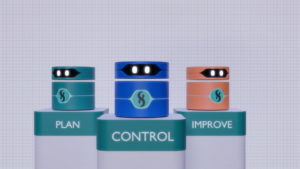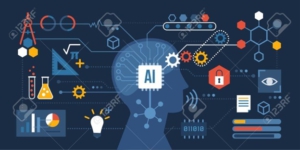Supply planning leaders are looking for “what’s next”?
Volatility of market factors and economic uncertainty are impacting every function of an enterprise today. Hyper-speed changes leave business-planning executives struggling to orchestrate rapid decision-making and achieve an optimal outcome.
This is particularly true of the supply chain planning process. Supplier de-commits, demand fluctuations and delivery adjustments occur several times a day. Production planning teams must adapt their build plans to optimally deliver on the current customer demand plan – which also changes daily. Supply planning software provides a part of the answer but represents siloed data that still requires people to make decisions and then take action.
Multi-tier supply visibility and risk management tools provide early warning data that can alert supply chain professionals to a potentially disruptive event. But these data must be integrated rapidly into the decision-making process, deliberating probabilistic outcomes to select the best course of action. The people responsible for this Decision-Action-Outcome loop must test and retest over and over as the circumstances and suggested actions change over time.
When faced with volatile business situations, questions and the need for decision-making come fast!
· Can I find, buy and get shipped an alternate part before my competitor gets it?
· What should the factory be working on today given what I can build?
· Of my decision choices, what are the respective impacts on revenue, margin, or customer satisfaction?
· What just happened since I started asking these questions that might change my answer?!
Execution teams encounter speed limitations with the current tool set

Today, integrated supply and business planning aims for an optimized build plan. These plans are built through a series of cross-functional meetings where participants bring the best information available at that time. Contributing program managers, data scientists, and business analysts have constrained perspectives based on their individual experiences and domain responsibility. Data input can come from a variety of internal and external sources. Those manually and asynchronously gathered data need to be coordinated and acted upon in unison. Most significantly, converting point-in-time insights into decisions and actions that solve underlying root-causes must be manually performed at each level of the organization, which is an often-tedious process.
Business Process Improvement, Robotic Process Automation and siloed software applications are not enough
Artificial intelligence has become a ubiquitous term used to describe a variety of algorithm-based tools. Many of these tools leverage technology to do the mundane tasks historically performed by people. Examples are Business Process Improvement (BPI) tools which gather data from a variety of data sources. Whether from the companies ERP system or from a project manager’s spreadsheet, today’s BPI technology tools gather the prescribed data elements and roll them up to a dashboard. But project managers and leaders are still left with the task of interpretation and decision-making.
Other systems capture process information that involves data and can move actions along just by imitating their human counterparts. Robotic Process Automation (RPA) captures the underlying logic in the if-this-then-that scenarios. Many functional-specific software platforms capture data and then repeat the inquiries or instructions usually performed by people i.e. “this event happened, go find out what suppliers are in that area.” However, even at this point, probabilistic supply alternatives, outcome-based selection choices and coordinated cross-functional action plans which tie to the newly selected build plan are still left up to analysts, project managers and other decision-makers.
New technology speeds the decision-action-outcome loop

Decision Intelligence (DI) closes this gap by automating the routine tasks, decision analysis, what-if planning usually performed under duress by already-stretched-or-hard-to-hire staff members. When disruptions occur, the Decision Intelligence systems can immediately detect the variance in plan. From there, it can be programmed to launch a pre-set protocol of data to gather, alternatives parts to find, purchases to make and even inform an established set of team members. Imagine this happening in seconds versus the normal S&OP process that might take days or even an entire week!
There are 3 main areas where Decision Intelligence systems can help humans take decision-making to the next level.
1) The ability to assimilate a near infinite amount of data points about the current situation at any point in time, instantly, from a myriad of both structured and unstructured data sources;
2) To consider all possible decisions and to launch actions given the circumstances collected in #1 above, including embedded expertise derived from prior events or topic specialists;
3) The ability to assess all probabilistic options across an array of desired outcomes and then make trade-offs depending upon the many factors which might impact a single decision.
As with the supply chain scenario described initially, the underlying real-world circumstances are constantly fluctuating. The decisions and therefore actions can potentially change minute-to-minute. Whether the bosses want to optimize for revenue, margin or customer satisfaction (e.g. relative on time delivery) impacts the decision and action plans.
A next-generation decision intelligence based decision-making approach is the best way to handle the current volatile and uncertain situations. This approach delivers optimal business outcomes that are the result of increasing both the speed and quality of the flow of interconnected decisions and actions within the enterprise.
The end result is higher velocity, quality and timeliness in decisions optimizing the operational metrics such as On-Time-In-Full deliveries, stock outs, inventory turns, perfect order rate, supply chain expedite costs, etc. thereby positively influencing the revenues, profitability, customer experience and significant value delivered by your organization.
What’s the limiting factor? It’s no longer that absence of compute power. Just like Chat GPT has been built upon Natural Language Processing to now deliver remarkable prose that mimic skilled writing prowess in seconds, decision intelligence builds upon prior AI efforts to replicate human decision making in the blink of an eye. How long will it take for supply chain professional to adopt this new way? Who will be the leaders that show us the way? Will it be your supply chain…. or your competitors?
For more on this topic, please contact the author.
Joe Carson
VP Business Development, ExperienceFlow



